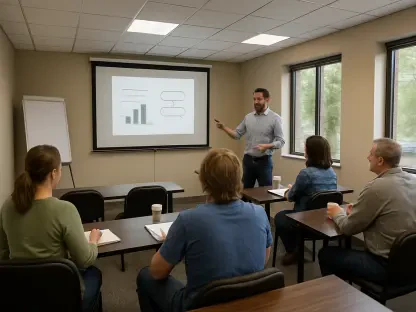In the quiet town of Craftsbury, Vermont, a small institution with a big mission faces an uncertain end as Sterling College, known for its unique focus on environmental studies and experiential learning, has announced its closure by spring 2026 due to severe enrollment declines and financial challenges. This decision has sent ripples through the higher education community, raising questions about the sustainability of niche colleges. This roundup gathers insights from various stakeholders—educators, administrators, industry analysts, and students—to explore why Sterling is closing, what this means for similar institutions, and how the sector might adapt to such challenges. The aim is to shed light on differing views and potential solutions for small colleges grappling with existential threats.
Unpacking the Reasons Behind the Closure
Enrollment Declines and Financial Strain
A significant point of consensus among higher education analysts is the devastating impact of enrollment drops on Sterling College. With a student body shrinking to fewer than 40 this semester, the college has seen a steep decline over recent years. Financial reports indicate that net tuition revenue has fallen sharply, now standing at just $835,700, a figure that underscores the institution’s struggle to remain viable. Many observers note that such declines are not unique to Sterling, reflecting broader demographic shifts with fewer high school graduates entering college.
Another perspective comes from financial experts in the education sector, who highlight Sterling’s limited endowment of $1.2 million and heavy reliance on restricted grants, which amounted to $4.9 million in recent data. These constraints left little room for fiscal maneuvering. Some argue that small colleges must diversify income sources beyond tuition and grants to survive, pointing to Sterling’s situation as a cautionary tale of over-dependence on narrow revenue streams.
A contrasting view from some administrators suggests that while finances are critical, the root issue lies in market positioning. They contend that Sterling’s highly specialized programs, while admirable, failed to attract a broad enough student base in an era where career-focused degrees often take precedence. This debate reveals a tension between maintaining a unique mission and adapting to economic realities.
Challenges of a Niche Environmental Mission
Educators familiar with Sterling’s model emphasize its distinctive identity as a work college with a 307-acre campus dedicated to outdoor learning in ecology and social justice. Students were required to contribute labor hours, engaging in activities like farming and camping, which aligned with the college’s environmental ethos. Many in this group lament the loss of such a hands-on, mission-driven approach, arguing that it offered unparalleled value to a specific type of learner.
However, industry analysts offer a more critical take, suggesting that Sterling’s narrow focus may have limited its appeal in a competitive higher education landscape. They point out that while the college’s commitment to sustainability and experiential education was innovative, it struggled to draw sustainable enrollment numbers. Some believe that broadening academic offerings could have provided a buffer against decline, though others counter that doing so might have diluted the core values that defined Sterling.
Students and alumni add a personal dimension, expressing mixed feelings about the closure. Many value the unique experiences gained through the college’s programs but acknowledge the difficulty of sustaining such a specialized institution. Their input underscores a broader question: how can niche colleges balance their distinct identities with the need to remain financially viable in a changing market?
Responses to the Planned Wind-Down
Strategies for a Responsible Closure
Administrators from various small colleges commend Sterling’s approach to closure, noting the transparency in planning a final commencement in May 2026. The college has taken steps to secure teach-out agreements with institutions like College of the Atlantic and Champlain College, pending accreditation approval, to ensure students can complete their education. This proactive stance is seen as a model for managing an inevitable shutdown with student welfare in mind.
Higher education consultants add that Sterling’s consideration of continuing its summer internship program through August 2026, if demand persists, shows an effort to preserve elements of its mission. They argue that such measures could serve as a blueprint for other institutions facing similar fates, emphasizing the importance of maintaining some legacy programs even during closure. This perspective highlights a shift toward viewing closure not as failure, but as a strategic pivot.
A differing opinion from some policy experts suggests that while Sterling’s wind-down is responsible, it also exposes gaps in support systems for small colleges. They advocate for more robust regional or federal assistance to prevent such closures in the first place, arguing that proactive intervention could save institutions before they reach a breaking point. This viewpoint sparks a debate on whether closures are inevitable or preventable with the right resources.
Future of Sterling’s Assets and Legacy
Speculation abounds regarding the fate of Sterling’s $3.4 million property, which includes forests, wetlands, and a farm. Environmental education advocates hope these natural assets can be repurposed for continued learning or conservation efforts under a new entity. They stress the importance of preserving the land’s role in promoting sustainability, aligning with Sterling’s original mission, and preventing commercial exploitation.
On the other hand, real estate and financial analysts predict that selling the property might be the most practical option given the college’s fiscal constraints. They reference past cases of college closures where land sales funded student transitions or debt repayment. However, they caution that such decisions must balance immediate financial needs with long-term community impact, a concern echoed by local stakeholders in Craftsbury.
A third perspective from higher education strategists explores the idea of partnerships with other organizations to maintain the campus for alternative educational purposes. They suggest models like community learning centers or environmental research hubs as viable paths forward. This diversity of opinions reflects the complexity of managing a college’s legacy assets post-closure, with no easy answers in sight.
Lessons and Implications for Small Colleges
Analysts across the board agree that Sterling’s struggle offers critical lessons for other small institutions, particularly the risks of low endowments and declining student numbers. Many emphasize the need for diversification, whether through expanded program offerings or new revenue models like corporate partnerships. This insight is seen as a wake-up call for colleges that have relied heavily on traditional income sources.
Educators and administrators also point to the value of strategic alliances, suggesting that small colleges could benefit from shared resources or mergers with larger institutions. They argue that collaboration can provide a safety net against financial instability, using Sterling’s isolated struggle as evidence of what happens without such support. This approach is gaining traction as a potential lifeline for vulnerable schools.
Students and alumni of similar niche colleges contribute a grassroots perspective, urging institutions to prioritize marketing and outreach to highlight their unique strengths. They believe that better visibility could attract more students, countering enrollment declines. Combined, these varied viewpoints paint a picture of a sector at a crossroads, with Sterling’s case serving as both a warning and a catalyst for change.
Reflecting on Broader Trends in Higher Education
Looking back, Sterling College’s closure announcement sparked vital conversations about the fragility of small, specialized institutions in an era of demographic and economic pressures. The insights gathered from educators, analysts, and students revealed a shared concern over financial sustainability, yet also showcased diverse ideas on adaptation and legacy preservation. The college’s transparent wind-down was widely praised, even as debates persisted over prevention versus closure.
Moving forward, the higher education community must consider actionable steps like fostering partnerships, diversifying revenue, and enhancing outreach to safeguard vulnerable colleges. Exploring case studies of successful turnarounds or innovative models could provide further guidance. Additionally, advocating for policy support at state and federal levels might offer a buffer against future closures, ensuring that mission-driven institutions have a fighting chance to thrive in a challenging landscape.








